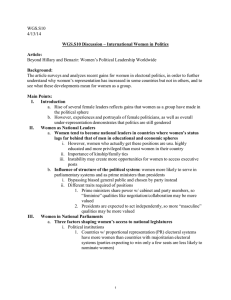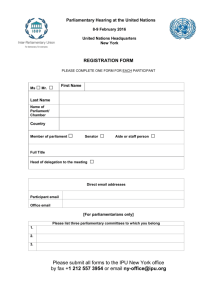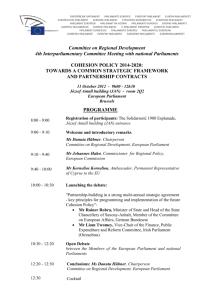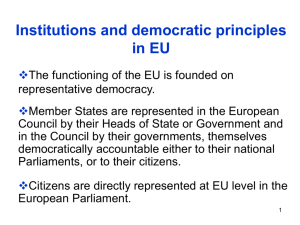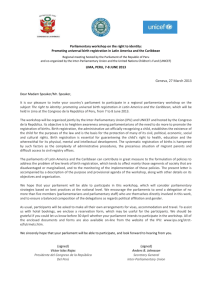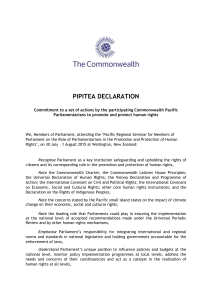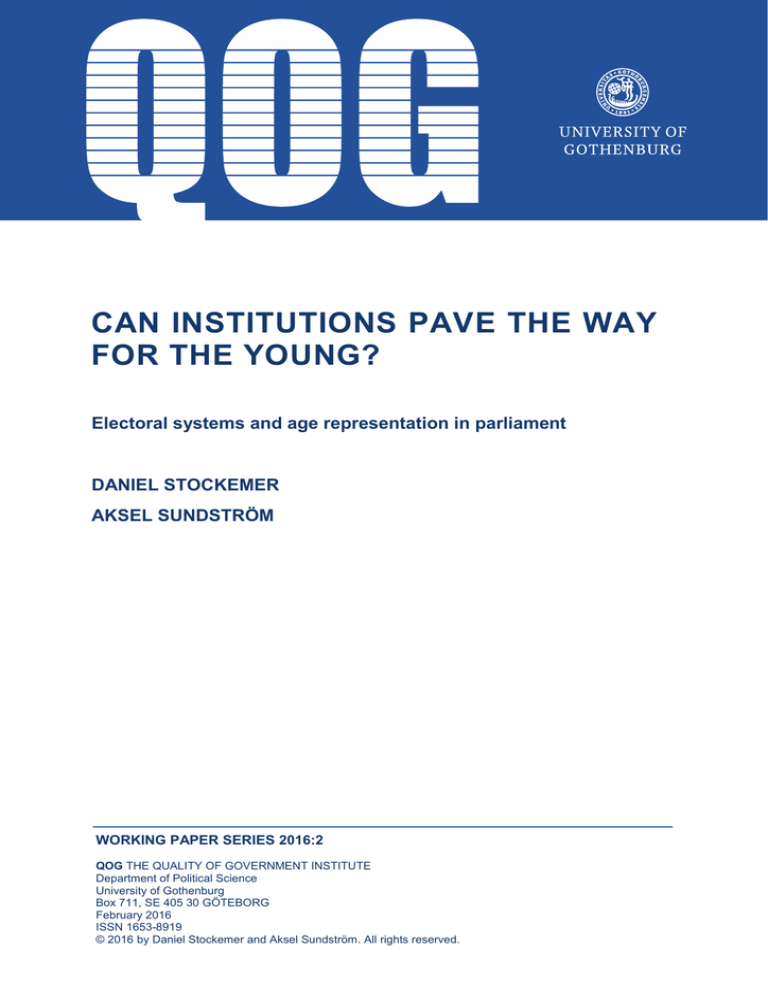
CAN INSTITUTIONS PAVE THE WAY
FOR THE YOUNG?
Electoral systems and age representation in parliament
DANIEL STOCKEMER
AKSEL SUNDSTRÖM
WORKING PAPER SERIES 2016:2
QOG THE QUALITY OF GOVERNMENT INSTITUTE
Department of Political Science
University of Gothenburg
Box 711, SE 405 30 GÖTEBORG
February 2016
ISSN 1653-8919
© 2016 by Daniel Stockemer and Aksel Sundström. All rights reserved.
Can institutions pave the way for the young? Electoral systems and age representation in parliament
Daniel Stockemer
Aksel Sundström
QoG Working Paper Series 2016:2
February 2016
ISSN 1653-8919
ABSTRACT
Middle-aged to senior men of the ethnic majority and higher income groups are generally
overrepresented in parliaments. While research on group representation has examined issues of
gender, economic standing and, more recently, ethnicity, few studies examine age groups. We argue
that the design of political institutions influences the average age of parliamentarians across nations
and suggest that, compared to majoritarian systems, PR systems should grant younger politicians
entry. Analyzing an original dataset we corroborate this argument in a global cross-national sample.
After controlling for a range of potential explanatory factors, we find that PR systems produce, on
average, a parliament with younger representatives.
Keywords; political representation; parliaments; comparative politics; election systems; age groups
Daniel Stockemer
School of Political Studies
The University of Ottawa
daniel.stockemer@uottawa.ca
Aksel Sundström
The Quality of Government Institute
Department of Political Science
University of Gothenburg
aksel.sundstrom@pol.gu.se
2
Introduction
In many countries, the social and political elite is mainly conceived of rather wealthy and educated
middle aged to senior men of the dominant ethnicity (Verba and Nie 1972). The parliamentary
arena fits this description (Kenny 2013). According to Norris (1997, p. 6), “legislatures worldwide
include more of the affluent than the less well-off, more men than women, more middle-aged than
young, and more white-collar professionals than blue-collar workers.” Substantiating Norris’ claim,
research on the social composition of parliaments has examined the presence of gender (Paxton et
al. 2007; Wängnerud 2009), economic standing (e.g. Carnes 2013; Bernauer et al. 2015) and, more
recently, the issue of ethnicity (see Hughes 2011; 2013). However, relatively absent from the representation literature is a discussion of age representation, despite the fact that there are similar normative claims as for the representation of women, social classes or minority groups to be made.
Both from a normative and from a policy point of view, the young cohorts of the population
should be represented in elected assemblies (Mansbridge 1999; Young 1997). Normatively, the
dominant presence of the elderly in legislatures cannot be justified on the basis of their “natural
superiority of talent” (Phillips 1995, p. 65). When it comes to policy, various age cohorts may have
contrasting views on political issues concerning welfare spending and budgeting priorities (i.e. middle-aged citizens may favor lower taxes, whereas younger cohorts of the population might favor
high spending on education and welfare). In fact, in relation to the political sphere, young citizens
have been described as an “excluded majority” (IPU 2014). Yet, as recently noted by Tremmel and
colleagues (2015), the literature on representation has rarely examined the standing of younger age
groups in parliaments.
If the representation of different age groups in parliament matters, then it is important to determine
why some parliaments are constituted by younger representatives than others. In this article, it is
our aim to explore this variance across countries. We hypothesize that proportional representation
(PR), because it incites parties to diversify their electoral slates, leads to younger parliaments than
majoritarian electoral system types. We test this argument in a multivariate framework based on a
large-scale dataset comprising around hundred countries. After controlling for a host of possible
covariates we find support for our hypotheses; that is, PR systems decrease the average age of
elected assemblies by more than three years.
3
The paper proceeds as follows. In the next section, we review the existing literature and build our
theoretical argument. In the third part, we describe and operationalize our variables. We then present and discuss our findings. The final section concludes and discusses avenues for future research.
Existing Literature
Driven by the concern that “the narrow social composition of legislatures suggests either that certain groups within society are less capable of representing others, or that something has gone awry
in the recruitment process” (Murray, 2014, p. 520), several literatures (e.g. the women’s representation literature and the literature on ethnic minorities) highlight that the composition of parliaments
matters. First, the feminist strand of research illustrates that a high presence of women in parliament can transform legislatures and influence policy. For one, the level of women’s presence in the
legislature shapes the degree to which women are able to be spokespersons for other women
(Childs 2004). Equally importantly, female parliamentarians differ from male parliamentarians in
terms of agenda setting and the introduction of women friendly policies. In addition, high women’s
presence in parliaments often leads to changing political discourses both inside and outside the
parliament (Celis 2008). Second, research on the parliamentary representation of ethnic and religious minorities highlight that representation of these minority groups helps foster their emancipation in other areas of society (Hero and Tolbert 1995). According to the minority empowerment
theory, the presence of minorities in legislatures strengthens the representational links of these
groups, fosters more positive attitudes toward government of the minority, but also the majority
group, and increases government responsiveness, in particularly, toward demands from disadvantaged groups (Banducci et al. 2004).
There is also a host of theoretical and empirical research investigating how issues of ethnicity and
social group composition intersect with political representation (see Hughes 2011; 2013). For example, Htun (2004) notes that gender is different from ethnicity since the latter more often coincides with existing political cleavages in comparison to the former. Focusing more on quotas,
Krook and O’brien (2010) highlight that reservation schemes and quotas for social groups in parties
and parliaments influence the saliency of different identities (be it gender or ethnicity) differently.
Bjarnegård and Zetterberg (2014) confirm this finding. While the literature on women’s and eth-
4
nicity representation is quite advanced, the same cannot be said for the literature looking at the
representation of various age cohorts. For sure, age representation cannot be compared one by one
to the representation of ethnic minorities or that of women. Gender and ethnicity are features that
are normally stable, across an individual’s life span, but age is not: Individuals inevitably become
older and therefore leave the category of being young. Yet, this does not make the study of age
representation less important. To the contrary, the share of young people is increasingly growing in
low-income societies and so are their claims for influence (UNDP 2013).
To defend the interests of younger individuals, citizens in their 20s and 30s must be represented in
parliament. This applies even more so, considering that age is an important predictor of political
agendas ranging from government financing of public education to defense spending (Shin 2001).
Preferences in social security matters, health care and pensions are also influenced by the age of the
citizens (Metz 2002). Aside from this direct influence on individual preferences, age has an indirect
influence on political partialities: the impact of age on preferences is more likely to emerge in how
these groups respond to variations in economic situations. In particular, traditional economic variables, such as income and tax price, appear to affect the preference patterns of the elderly differently
from than those of non-elders (Duncombe et al. 2003, p. 71)
The problem of unequal age representation becomes increasingly important the more there is a
discrepancy between the average or median age in parliament and the average or median age in the
population. Throughout the world the difference in age patterns in parliament and in society are
immense. In the sample of 102 countries that serve as the basis for this study (see appendix 1) the
mean age in the population is around 35 years.1 This is contrasting to the age distribution among
parliamentarians in our dataset, with an average age slightly above 52. In fact, there is no country in
this sample in which the age of parliamentarians is representative of the age of populations. In particular, in low-income countries with a demographic distribution that render young people to be in
the majority in the population, the gap between the average age of parliamentarians and the average
age of the population is very large. For instance, in India, the mean age in the population is below
28 years. However, the average age of members in the lower house of the Indian Parliament, the
Lok Sabha, is roughly 57 years, which constitutes a nearly 30 year gap (The ballot 2015).
1
The data is taken from the CIA World Factbook, the year 2014. While we ideally would have liked to find figures on the
mean age of populations, such data is currently not collected in this publication.
5
The policy sphere and political actors have started to react to the discrepancy between the mean or
median age in the population and the mean or median age in parliaments. For example, several
high-level reports issued by the United Nations have called attention to the lack of participation
and representation in politics of young adults around the world and warned of the growing apathy
among the young (see UNDP 2013, 2014). More concrete, some countries have enacted policies to
counter traditional recruitment traditions to political posts that tend to benefit the middle-ages and
the elderly. For instance, a smaller number of countries including Rwanda and Uganda have created
reservation schemes for “youths”, where a quota ensures a certain percentage of the seats in parliament for candidates under a certain age (see Tremmel et al. 2015). More indirect, another response by political actors has been the rise of youth wings within the political structures of established parties and even more pronounced the emergence of so-called youth parties such as the UK
Youth Party or the Youth Party of India that are composed of young adults and that fight for the
demands of the younger generations (Hooghe et al. 2004).
However, the academic literature on youth representation has not kept up with these new developments. While age is given importance in the literature on political behavior of citizens when analyzing voter turnout (see e.g. Bhatti et. al 2012; Bhatti and Hansen 2012), or in political theory when
discussing the lack of influence for young in decision-making (van Parijs 1996), the study of political representation has rarely focused on the social category of age groups. Aside from single-nation
studies on related topics that note in passing that the middle-aged and the elderly are overrepresented in national parliaments, there is less than a dozen studies on age representation particularly
(e.g. Norris and Franklin 1997; Joshi 2013; Kissau et al. 2012; IPU 2014).
Existing work can be divided into four types of analyses: First, without providing any solid proof
for this claim, introductory handbooks to the study of government frequently state that legislators
are normally middle-aged to senior (e.g. Blondel 1995, p. 257). Second, several case studies either
explicitly or implicitly mention that there is an overrepresentation of middle-aged and senior individuals among legislators, in a larger perspective (see Norris 1997) but also in specific countries,
including France (Murray 2008), Sweden (Burness 2000), or Switzerland (Kissau et al. 2012). In
more detail, these studies all confirm that the age group between 50 and 60 constitutes the largest
share of elected legislators. Third, there is one edited book by Tremmel et al. (2015) that discusses
the normative and empirical implications of the installation of quotas for youths in parliaments (see
Hainz 2015; Karnein and Roser 2015). Yet, the volume also establishes that there is a gap in empir-
6
ical research on representation where few comparative studies take the issue of age group representation seriously.
Fourth, there are less than a handful of comparative studies that explicitly discuss the representation of various age cohorts in parliament. For example, Narud and Valen (2000), compare age representation in the legislatures in the Nordic countries and find that is, individuals in their fifties and
sixties are the strongest age cohorts in terms of representation. Broadening the number of cases to
70, a report on age representation published by the Inter Parliamentary Union (IPU) in 2014 confirms the underrepresentation of young adults. According to the IPU two thirds of single and lower
houses of parliament have two per cent or fewer young parliamentarians (defined at age 30 or
younger). All upper houses have less than six per cent young adults in their ranks, with three quarters electing no young person at all. Finally, Joshi (2013) focusing on the representation of distinct
age groups in 14 Asian countries. Joshi finds that proportional representation fosters the representation of young adults in the 14 Asian parliaments under consideration. In this study, we build on
Joshi in two ways. (1) Theoretically, we offer a theory why proportional representation (PR) should
foster the representation of young individuals. (2) Second, using a large scale dataset that includes
data for more than 100 countries, we confirm the hypotheses that parliaments elected under PR
trigger younger parliamentarians, on average.
Theory
Institutions are central to the political representation literature. For example, more than 50 years of
research on women’s representation have confirmed that the two institutional factors – quota provisions and the electoral system type – are strong predictors of cross country variation in women’s
representation (Tripp and Kang 2008; Paxton et al. 2010). In terms of quotas, there is strong support that legislative quotas, and, to a lesser extent, voluntary party quotas are an effective means to
boost the representation of women in parliament (Krook 2009). In terms of the electoral system
type, proportional representation is generally found to boost the representation of women by several percentage points (Matland 2005). In this article we argue that what applies to women’s representation should also, to a large extent, apply to younger individuals, since these are both groups
that are generally marginalized in politics dominated by middle-aged men. More specifically, we
hypothesize that, compared to majoritarian systems, proportional systems should render parliaments younger. There are at least four theoretical arguments to substantiate this hypothesis.
7
First, first past the post systems create a zero sum game for parties. Each district is like a separate
election. In order to win, any party faces some strong incentive to put forward the candidate that,
on average, can garner the most votes. In most districts, middle aged to senior men of the dominant ethnicity with high education fulfill this profile best (Henig and Henig 2001). In contrast, the
same zero sum mentality does not exist in PR systems. Rather contrary, parties have an incentive to
diversify their slates to appeal to as many constituencies as possible (Rule 1987). Party gatekeepers
must also think in terms of appeal; in order to appeal to the young electorate and entice young citizens aged 18 and up to vote it is beneficial if parties have somebody in the age group 18 to 35 on
the electoral slate; somebody whom these young citizens can directly relate to. Hence, in terms of
vote gains, adding young candidates to the list can be seen beneficial rather than disadvantageous
for parties. This implies that instead of the uniformity of candidates, which should be the main
feature in majoritarian systems, PR systems – especially in large districts – should be characterized
by balanced tickets Matland (2005, p. 101).
Second, PR systems are party centered. This means that party elites can push forward certain types
of candidates such as the young (Norris 2006). In contrast, majoritarian systems are candidate centered. However, a candidate centered party system disfavors young candidates in two ways. First, in
order to win the primary of a major party, candidates need a political record, name recognition, as
well as financial and organizational resources to run a campaign (Ashe and Stewart 2012); all qualities that senior and more experienced candidates rather than young candidates are likely to have. In
PR systems there are normally no primaries, which eliminate one hurdle that young individuals
must overcome in order to gain candidate status. Second, the incumbency advantage, which is more
pronounced in first past the post systems, is likely to hurt young individuals. For example, in single
member district countries such as the United States of America, with a retention rate of 90 percent
from one election to the next, there are few seats open for young individuals (Ashworth and Bueno
de Mesquita 2008). In contrast, in PR systems turnover rates are higher, which increases the chances of outgroups or underrepresented groups such as the young to access candidate lists (Matland
and Studlar 2004)
Third, the mechanical effects of PR and plurality are different. PR normally tends to generate multiparty systems whereas plurality favors two party systems. Multiparty systems could indirectly benefit young individuals (Joshi 2013). Because the barriers to gain representation are lower, progressive
8
parties such as Green parties can gain sizeable representation in PR countries (for example, see
Germany and the Nordic countries). In terms of policy these progressive parties push postmaterialist values such as the environment, gender equality or direct democracy. In terms of political appeal, these parties are not only most popular among young voters, they also represent a new
generation of representatives: MPs that are younger, less traditional and more geared towards issues
interesting to young voters, such as the abolishment of the draft or decreasing the minimum voting
age (Siaroff 2000).
Fourth, PR systems are more prone to a contagion effect; that is, if one party starts to nominate
more young candidates other are parties are likely to follow suit. In other words and more generally,
under PR a party can likely respond positively to calls to nominate more young contestants (Fawcett 2002). For one, it does not have to convince incumbents or other senior parties to step aside,
as there might still be space on the party list to also nominate young voters (Joshi 2013). In addition, the gains for diversifying the electoral slate might be larger under PR. Adding just a few young
candidates to the list could give the party a younger and more dynamic output. The same would not
necessarily happen in first past the post systems, even if a party was to nominate some young candidates to districts (Matland and Studlar 1996).
Control Variables
While it is the main goal of this article to evaluate the relationship between electoral systems and
age representation in parliament, we still have to control for other possibly relevant factors, which
might also account for why some parliaments are younger than others. The control variables are age
quotas, age of candidacy law, regime type, development, corruption, median age of the population
and the share of Muslims in the population. We mainly derived the rationale for inclusion of these
variables from the women’s representation literature.
Age quotas
The women’s representation literature nearly unanimously agrees that legislative gender quotas are
effective in increasing the share of elected women (Krook 2009). Guaranteeing women a set percentage of the seats in parliament or on electoral lists is an efficient means to boost the representation of female representatives (Paxton and Hughes 2015). The same rationale should apply for the
representation of the young. If there are reserved seats or legal provisions in a country forcing par-
9
ties to nominate young candidates, the younger cohorts of the population should be more highly
represented and the national parliament, in general, should be younger (Krook and O’brien 2010).
According to recent publications (UNDP 2013; IPU 2014; Quota Project 2016) there are four
countries with reserved seats for youths in the parliament and seven countries with political parties
using youth quotas.2 In the analysis we account for possible effects from such age quotas.
Age of candidacy law
For some countries, the voting age and the age at which you can become a candidate are not the
same (UNDP 2013). To illustrate, while the voting age is 18 years in countries such as Brazil, Indonesia and Pakistan, people cannot stand for election to the national legislative assembly in such
countries until they are 21 years old (IPU 2014). We believe that having an age limit for candidacies
that is higher than the age limit to vote could influence the cross-national variance of age among
representatives in legislatures directly and indirectly; directly since such rules effectively could hinder the youngest candidates to gain entrance to parliamentary seats and indirectly since it sends the
signals to potential candidates that politics is not a business for young people. We therefore include
this as a control in our model.
Regime Type
Democracies are the only regime type that guarantees procedural and constitutional equality to all
citizens. In theory, a democratic state ought to strife to include individuals of all genders,
backrounds, religions and ages in positions of power (Sartori 1992). In practice, this ideal is questioned when it comes to women’s representation. While, Paxton et al. (2010) find that democracy
levels have an influence on the share of elected women in parliament, even after controlling for a
host of other factors, other analyses (e.g. Stockemer 2009; 2011) disconfirm this link. In this study,
we test whether democratic systems are more responsive than non-democracies to claims for a
more balanced representation in terms of age.
Development
According to Inglehart’s (1997) influential post-materialism thesis, economic development is accompanied by changing values. In particular, the transformation from industrial to post-industrial
2 The countries with age quotas in parliament are Kenya, Morocco, Rwanda and Uganda. The countries with parties
having reservation schemes for youths are Croatia, Egypt, Germany, Netherlands, Nicaragua, Senegal and Tunisia.
Moreover, Peru and Sri Lanka has age quotas on elected seats at the sub-national level for local councils.
10
or service sector societies should trigger a change in dominant values (Inglehart and Welzel 2008).
Whereas in agrarian and, to a lesser degree, in industrial societies, traditional and materialist values
ought to prevail, service sector societies should be characterized by post-materialist values including
attitudes among most people promoting gender equality, environmental protection, and increased
participation in decision making (Norris and Inglehart 2003). This post-materialist shift should be
beneficial to outgroups, such as, minorities, women and the youth. In particular, and because this
transformation of societies is pushed by younger generations, we hypothesize that higher levels of
economic development should be conducive to younger parliaments.
Corruption
We believe that young candidates may face obstacles in becoming elected in highly corrupt contexts. Besides formal political institutions such as the electoral system type or the regime type, there
are also informal procedures, which might influence the representation of various groups in parliament. One of these procedures might be corruption. “Corruption “indicates the presence of ‘shadowy arrangements’ that benefit the already privileged” (Sundström and Wängnerud 2014, p. 2),
which very seldom are the younger cohorts in society. According to this reasoning, the existence of
corruption or clientelism should benefit candidates that are within the dominant norm: “Only those
with access to networks, those with connections within the local or national elite, those with resources to finance corrupt behavior, and those who are already influential in society are in positions
to be considered assets in clientelist networks and are the only ones who will be trusted with the
sensitive nature of the exchange” (Bjarnegård 2013, p. 37). For this reason, we believe that the
middle-aged and the elderly should be overrepresented in parliament when corruption is widespread.
Share of Muslim in the population
In particular, in its traditional form, Islam as a religion is characterized by a traditional life style,
patriarchy, and hierarchical power structures (Weiffen 2004). To support this claim, research also
shown that a strict and traditional interpretation of Islam inhibits outgroups such as women, religious minorities and the young (Blaydes and Linzer 2008). For example, Norris (1999) indicates
that societies with a high share of Muslim populations tend to have a poor record of including
women in their legislatures. We believe that Muslim dominant countries may also be more reluctant
than others to welcome young cohorts in their parliaments: this should apply even more so considering that recruitments to elite positions are frequently made by seniority.
11
Median Age in the Population
The age distribution in society may be an important predictor of the average age in parliament. If
voters are seeking representatives that reflect their own interests, they may choose candidates that
are roughly their age (Henn and Foard 2012). For the individual level, this would imply that adults
in the 20s and 30s should be more inclined to vote for candidates, who are roughly their age, either
by selecting certain candidates or supporting parties with more young candidates on their party lists.
For the macro-level, this would then entail that populations that are younger ought to have younger
parliaments.
Operationalization of variables
Dependent variable
In contrast to other measures of group representation such as women’s or minority groups’ representation, the operationalization of different representational age categories or young parliamentarians is somewhat tricky. This applies even more so, considering that previous studies operationalize
age groups in different ways. Joshi (2013), for instance, discusses that the meaning of age varies
across cultures: what is “youth” may differ in say Japan compared to Nigeria. After careful consideration, Joshi (2013, p. 7) opts for a rather broad operationalization and includes in the category the
“young generation” all individuals of 40 years and below. Similarly, the descriptive report on age
representation by the IPU (2014, p. 2) notes that the group young parliamentarians can include
people below 30, 35, 40 or even 45 years of age. In the end, the IPU uses the rules and working
modalities of the IPU Forum of Young Parliamentarians, and considers “’young’ anybody under
the age of 45” (p. 2). More restricted, Norris and Franklin (1997) talk about “the younger generation”, that is, people of 35 years of age and below.
We believe that rather than setting any arbitrary benchmark for young parliamentarians, we just
calculate the average age. The idea is that the more young representatives are in parliament, however one defines this category, the lower the average age in parliament should be. To calculate the
average age in parliament, we normally retrieved the age of any parliamentarian from her or his
personal bibliography, which we normally found on parliamentary website of any given country.
For several countries statistical authorities provided a figure of the average age of members in the
parliament. Having retrieved the age from every parliamentarian, we then calculated the average age
of the parliamentarians per country. In total, we could retrieve data for the average age of parlia-
12
mentarians for 102 countries (i.e. 13 countries in Africa, 15 in the Americas, 26 in Asia, 41 in Europe, and 7 in Oceania (for a list of countries, see Appendix 1).3 In cases where there is a bicameral
parliament we focused on the lower house. The distribution of this novel variable is given in appendix 1, for each of the countries in the analysis. Similarly, Figure 1 reports the univariate distribution of this variable in a histogram.
Independent variable
To measure the electoral system type, we use two dummy variables, one for PR electoral systems and
anther one for mixed electoral systems. The category of PR electoral systems also includes countries
with a mixed member-proportional electoral system as the vote distribution in this type of system
follows the logic of PR. The reference category is plurality or majoritarian systems. We collected the
data for electoral system types from the website of the International Institute for Democracy and
Electoral Assistance (IDEA) (2014).
Control variables
The first institutional control variable, age quotas, is a dummy variable coded 1 for countries with
youth quotas in parliament or in political parties and 0 otherwise.4 The variable gauging the age of
candidacy law in a country measures the threshold on age in which persons are eligible for being
elected to national parliament (lower house where applicable). The indicator is a continuous variable denoting the age in which citizens may run for such positions. The data was collected from the
UNDP (2013) as well as national websites for a small number of additional countries. We operationalize regime type as the second institutional variable by two dummy variables (i.e. one for hybrid
regimes and one for autocracy, with democracies serving as the reference category). To distinguish
these three regime types, we use Polity IV data (Marshall et al. 2014). Following Polity’s recommendations, we code a country that has a democracy ranking of 6 or higher as a democracy, countries with a ranking between -5 and +5 as a hybrid regime or anocracy, and countries with a ranking
of -6 or lower as an autocracy. We gauge development by the GDP per capita in a country. Because
we cannot necessarily assume a linear relationship between increases in material wealth and decreases in the average age of the parliament, we log transform the GDP variable. The data source is
3
We have data for age in 102 countries. When introducing control variables in our analysis, we loose three cases
(Monaco, People’s Republic of Korea and San Marino) for which no data on corruption exists and thus include 99 nations in our final models)
4
In this variable 11 countries receive the value one. We also created a narrower variable, only including the four countries with reserved seats in the legislature. No matter which one of the two variables we use, the main results of our
models remain the same.
13
the United Nations (2014). We include a measure of corruption in a country, which we operationalize
by using the 2014 Control of Corruption Indicator from the Worldwide Governance Indicators
(WGI) project, run by the World Bank. Their variable Control of Corruption, ranges from -2.5 to +
2.5 and captures perceptions of the extent to which public power is exercised for private gain, including both petty and grand forms of corruption, as well as "capture" of the state by elites and
private interests (World Bank 2014). Moreover, we measure the share of Muslims in a country, which
we collect from CIA World Factbook (2014) as well as figures from national authorities from a
limited number of cases. The final variable measures the median age in the population as calculated by
the CIA World Factbook (2014).
Methods
To gauge the influence of the electoral system type on the average age of the parliament, we collected cross-national data for 102 countries (i.e. all countries for which data on the age of parliamentarians is available), as well as data for all the covariates. We use these data for two types of
analysis. First, we compare the average age of parliamentarians per country across PR systems and
non-PR systems. Second and even more importantly, we gauge PR’s effect on the average age in a
multivariate framework via an OLS regression analysis. On the left hand side is our dependent variable, the mean age of parliamentarians, and on the right hand side are the two dummy variables for
proportional and mixed systems, as well as the seven theoretically informed control variables. Before running the model, we test for normality. The information in Figure 1 suggests that the dependent variable is normally distributed. This indicates that OLS provides unbiased and efficient
estimates.
14
FIGURE 1, HISTOGRAM OF THE DISTRIBUTION OF AVERAGE AGE IN PARLIAMENT
Results
The summary statistics reported in Table 1 indicates that the average age of parliamentarians in our
dataset is 52.91, or nearly 53 years of age. If we calculate the age of parliamentarians in PR systems
and in non-PR systems, countries without PR systems have a mean age of 54.7 years, while the
ones with a PR system have a mean age of 51.6 years (see Figure 1). If we split the age of the parliamentarians in the three electoral system types our results indicate that the average age in parliaments is 51.56 years in PR systems, 52.06 in mixed systems and 54.36 in plurality and majority systems. As such these bivariate statistics already lent support for our hypothesis that PR systems, on
average, trigger younger parliaments.
15
TABLE 1, SUMMARY STATISTICS OF THE DEPENDENT VARIABLE AND THE INDEPENDENT VARIABLES
Mean
Std.
Min
Max
Average age in parliament
52.91
4. 18
42.90
70.20
PR elections system
0.57
0.50
0
1
Mixed elections system
0.09
0.29
0
1
Autocracy regime type
0.12
0.32
0
1
Hybrid regime type
0.17
0.37
0
1
Corruption
0.28
1.06
-1.43
2.41
Muslim share of population
16.08
29.53
0
99.8
Median age in population
33.18
8.58
15.50
51.1
Log GDP/cap
9.64
1.10
7.25
11.42
Age quotas
0.02
0.14
0
1
Age of candidacy law
18.46
1.32
18
25
FIGURE 2, BOXPLOT OF THE AVERAGE AGE IN PARLIAMENT DISTRIBUTED BETWEEN ELECTORAL SYSTEM TYPES
16
When proceeding to a regression analysis framework, the multivariate analysis confirms this finding. The effect of having a PR election system is negative and significant (p = 0.022). In detail, and
holding everything else constant, the model suggests that countries with a PR election system have
a 3.1 years lower average age compared to countries with plurality. Given a mean age of nearly 53
and standard deviation of slightly above 4, this difference in the age of parliamentarians between
PR and plurality systems is quite substantial. This applies even more so considering that the dummy
variable is the only statistically significant variable in the model. It is also worth noting that even if
the coefficient is not statistically significant, mixed systems also seem to have younger parliaments
than majoritarian systems.
TABLE 2, DETERMINANTS OF THE AVERAGE AGE OF MEMBERS IN PARLIAMENT. RESULTS OF
THE MULTIVARIATE REGRESSION ANALYSIS
Coefficient
Std. Error
Sig.
PR elections system
-3.14
1.35
.022
Mixed elections system
-2.42
1.82
.187
Autocracy regime type
0.37
2.75
.892
Hybrid regime type
-2.21
1.54
.159
Corruption
-0.58
0.76
.468
Muslim share of the population
0.02
0.02
.317
Median age in population
-0.03
0.11
.812
Log GDP/cap
0.92
1.04
.394
Age quotas (widely defined)
-1.41
2.17
.513
Age of candidacy law
0.42
0.24
.501
Constant
44.30
7.38
.000
Rsquared
.22
Root MSE
4.45
N
99
In this study we find support for our initial hypothesis; that is, it is true that electoral systems
change the composition of the legislature. Proportional representation not only increases women’s
and minority representation, it also makes parliaments younger; thus decreasing the gap between
the average age in the population and the average age in parliament. PR systems do both; they render it easier for parties to add young candidates on their lists and they provide an incentive for political actors to nominate younger deputies. The implications of this study therefore echoes Matland’s (2005) assessment that electoral systems are more malleable than other factors that affect
recruitment to the legislature, such as development. In terms of policy, our study is hence a plea for
17
PR. If political actors care about having a parliament that is (more) representative of the population
they should consider implementing PR.
Conclusions
Explicitly focusing on proportional representation, our study is one of the first to analytically assess
the representation of age groups in parliaments in a comparative large N perspective. Our finding,
that PR election systems render parliaments by more than three years younger than majoritarian
systems, on average, reinforces the notion that such systems are more open to “newcomers” in
politics. We also contribute to the ongoing discussion on the relationship between electoral system
design and the representation of social groups. Adding to the results of previous research on representation we can say that not only many traditional outgroups to the political and parliamentary
process – be it women, poorer segments of the citizenry, and ethnic or religious minorities, but also
young individuals – have a higher change of getting representation in a proportional list system as
compared to a single member systems. PR systems might face challenges in terms of accountability,
but they allow for a proportional translation of votes into seats and create parliaments that are
more representative of the population.
We believe that this study informs future research in two directions. First, we hope that this research entices others to look into the fascinating topic of the representation of various age cohorts
in parliaments and other elective and non-elective political bodies. If we want inclusive parliaments
it is not enough to represent minorities, various social classes and the two genders, it is also important to have the voices of the young, the middle aged and the elderly heard in parliament. Second, and relatedly we hope that our study encourages more work on age representation. Are there
other factors than the ones included in this study that influence the representation of various age
cohorts or that influence the average age in parliaments? What is the socio-economic profile of
young parliamentarians? For what type of elections do young candidates get elected in higher number? While we have asked some important questions, that hopefully future research will address, we
nevertheless hope that this study pushes the still scarce literature on the representation of various
age cohorts in parliament forward.
18
REFERENCES
Ashe, J. and K. Stewart 2012. Legislative recruitment: Using diagnostic testing to explain
underrepresentation. Party Politics 18 (5): 687-707.
Ashworth, S. and E. Bueno de Mesquita 2008. Electoral Selection, Strategic Challenger Entry and
the Incumbency Advantage. The Journal of Politics 70 (4): 1006-1025.
Banducci S. A., T. Donovan, and J. A. Karp 2004. Minority Representation, Empowerment, and
Participation. Journal of Politics 66 (2): 534-556.
Bernauer, J., N. Giger and J. Rosset. 2015. Mind the gap: Do proportional electoral systems foster
a more equal representation of women and men, poor and rich? International Political Science Review 36
(1): 78-98.
Bhatti, Y., K. M. Hansen and H. Wass. 2012. The relationship between age and turnout –
curvilinear or a rollercoaster? Electoral Studies 31 (3): 588-593.
Bhatti, Y. and K. M. Hansen. 2012. The effect of generation and age on turnout to the European
Parliament – How turnout will continue to decline in the future. Electoral Studies 31 (2): 262-272.
Bjarnegård, E. 2013. Gender, Informal Institutions and Political Recruitment: Examining Male Dominance in
Parliamentary Representation. New York: Palgrave McMillan.
Bjarnegård, E. and P. Zetterberg. 2014. Why Are Representational Guarantees Adopted for
Women and Minorities? Comparing Constituency Formation and Electoral Quota Design Within
Countries. Representation, 50 (3): 307-320.
Blaydes L. and D. A. Linzer 2008. The Political Economy of Women’s Support for Fundamentalist
Islam. World Politics, 60 (4): 576-609.
Blondel, J. 1995. Comparative Government: An Introduction. Hertfordshire: Harvester Wheatsheaf.
Burness, C. 2000. Young Swedish members of parliament: Changing the world? Nora: Nordic Journal
of Women's Studies 8 (2): 93-106.
19
Carnes, N. 2013. White-collar government: The hidden role of class in economic policy making. Chicago:
University of Chicago Press.
Celis, K. 2008. Studying women’s substantive representation in legislatures: When representative
acts, contexts and women’s interests become important. Representation 44 (2): 111-123.
Celis K., S. Childs, J. Kantola and M. L. Krook. 2008. Rethinking Women’s Substantive
Representation. Representation 44 (2): 99-110.
Childs, S. 2004. Women Representing Women, New Labour’s Women’s MPs. London: Routledge.
Central Intelligence Agency (CIA) 2014. The World Factbook. Accessed on June 23, 2015 from
https://www.cia.gov/library/publications/the-world-factbook/
Duncombe, W., M. Robbins and J. Stonecash. 2003. Measuring citizen preferences for public
services using surveys: does a ‘gray peril’ threaten funding for public education? Public Budgeting &
Finance 23 (1): 45-72.
Fawcett, C. 2002. Latin American Youth in Transition: A Policy Paper on Youth Unemployment in
Latin America and the Caribbean. Labor Markets Policy Briefs Series. Intera-American Development
Bank.
Hainz, T. 2015. Are youth quotas a form of ageism? In (Eds.) Tremmel J., A. Mason, P.
Haakenstad, and G.,I. Dimitrijoski. 2015. Youth Quotas and other Efficient Forms of Youth Participation in
Ageing Societies. Netherlands: Springer Verlaag.
Henn, M. and N. Foard 2012. Young People, Political Participation and Trust in Britain.
Parliamentary Affairs 65 (1): 47-67.
Hero, R. E. and C. J. Tolbert 1995. Latinos and Substantive Representation in the U.S. House of
Representatives: Direct, Indirect, or Nonexistent. American Journal of Political Science 39 (3): 640-652.
Hooghe, M., D. Stolle and P. Stouthuysen 2004. Head Start in Politics: The Recruitment Function
of Youth Organizations of Political Parties in Belgium (Flanders). Party Politics 10 (2): 193-212.
Htun, M. 2004. Is Gender like Ethnicity? The Political Representation of Identity Groups.
Perspectives on Politics. 2 (3): 439-458.
20
Hughes, M. 2013. The Intersection of Gender and Minority Status in National Legislatures: The
Minority Women Legislative Index. Legislative Studies Quarterly 38 (4): 489-516.
Hughes, M. 2011. Intersectionality, Quotas, and Minority Women's Political Representation
Worldwide. American Political Science Review 105 (3): 604-620.
IDEA.
2014.
Table
of
electoral
systems
worldwide.
Available
online,
http://www.idea.int/esd/world.cfm
Inglehart, R. 1997. Modernization and postmodernization. Princeton: Princeton Univ. Press.
Inglehart, R., and P. Norris. 2003. Rising tide: Gender equality and cultural changes around the world.
Cambridge: Cambridge Univ. Press.
Inglehart, R., and C. Welzel. 2005. Modernization, cultural change and democracy. New York: Cambridge
Univ. Press.
Inter-Parliamentary Union (IPU). 2014. Youth participation in national parliaments. IPU. ISBN 078-929142-619-5.
Joshi, D. K. 2013. The Representation of Younger Age Cohorts in Asian Parliaments: Do Electoral
Systems Make a Difference? Representation 49 (1): 1-16.
Karnein, A. and D. Roser. 2015. Saving the Planet by Empowering the Young? In (Eds.) Tremmel
J., A. Mason, P. Haakenstad, and G.,I. Dimitrijoski. 2015. Youth Quotas and other Efficient Forms of
Youth Participation in Ageing Societies. Netherlands: Springer Verlaag.
Kenny, M. 2013. Gender and Political Recruitment: Theorizing Institutional Change. Basingstoke: Palgrave
Macmillan.
Kissau, K., G. Lutz, and J. Rosset. 2012. Unequal representation of age groups in Switzerland.
Representation 48 (1): 63-81.
Krook, M. L. 2009. Quotas for women in politics: Gender and candidate selection reform worldwide. New York:
Oxford University Press.
Krook, M-L. and D. O’Brien. 2010. The Politics of Group Representation: Quotas for Women and
Minorities Worldwide. Comparative Politics 42 (3): 253-72.
21
Mansbridge, J. 1999. Should blacks represent blacks and women represent women? A contingent
‘yes’. Journal of Politics 61 (3): 628-657.
Matland, R. E. 2005. Enhancing Women’s Political Participation: Legislative Recruitment and
Electoral Systems. In: J. Balligton and A. Karam. (Eds.) Women in Parliament: Beyond Numbers. IDEA
International: Stockholm.
Matland, R. and D. Studlar. 1996. The contagion of women candidates in single-member district
and proportional representation electoral systems: Canada and Norway. Journal of Politics 58(3): 707733.
Matthews, H., L. Melanie, and M. Taylor. 1999. Young people’s participation and representation in
society. Geoforum 30: 135-144.
Metz, D. 2002. The politics of population ageing. The Political Quarterly 73 (3): 321-327.
Monty, G. M., T. R. Gurr, and K. Jaggers 2014. Polity IV Project: Political Regime Characteristics
and Transitions, 1800-2013. Center for Systematic Peace. Accessed on October 15, 2015 from
systemicpeace.org.
Murray, R. 2014. Quotas for Men: Reframing Gender Quotas as a Means of Improving
Representation for All. American Political Science Review 108 (3): 520-532.
Murray, R. 2008. The Power of Sex and Incumbency: A Longitudinal Study of Electoral
Performance in France. Party Politics 14 (5): 539-554.
Narud, H. M. and H. Valen. 2000. Does social background matter? In: P. Esaiasson and K. Heidar
(eds.). Beyond Westminster and Congress: The Nordic Experience. Columbus: Ohio State University Press.
Norris, P. and M. Franklin. 1997. Social representation. European Journal of Political Research 32: 185–
210.
Norris, P. 1997. Passages to power: Legislative recruitment in advanced democracies. Cambridge: Cambridge
University Press.
Norris, P. 1999. Petroleum patriarchy? A response to Ross. Politics & Gender 5 (4): 553-560.
22
Norris, P. 2006. Impact of Electoral Reform on Women's Representation. Acta Politica 41(2): 197213.
Paxton, P., S. Kunovich and M. H. Hughes. 2007. Gender in politics. Annual Review of Sociology 33:
263-284.
Paxton, P., M. H. Hughes, and M. A. Painter. 2010. Growth in women’s political representation: A
longitudinal exploration of democracy, electoral system and gender quotas. European Journal of
Political Research 49: 25-52.
Paxton, P. and M. H. Hughes 2015. The Increasing Effectiveness of National Gender Quotas,
1990–2010. Legislative Studies Quarterly 40 (3): 331-362.
Phillips, A. 1995. The politics of presence. Oxford: Oxford University Press.
Rule, W. 1987. Electoral Systems, Contextual Factors and Women’s Opportunity for Election to
Parliament in Twenty-Three Democracies. Western Political Quarterly 40 (3): 477–498.
Sartori, G. 1992. Demokratietheorien. Darmstadt: Wissenschaftliche Buchgesellschaft.
Shin, E. H. 2001. Political demography of Korea: Political effects of changes in population
composition and distribution. East Asia 19 (1): 171-204.
Siaroff, A. 2000. Women’s Representation in Legislatures and Cabinets in Industrial Democracies.
International Political Science Review 21 (2): 197–215.
Stockemer, D. 2009. Women’s Parliamentary Representation: Are Women More Highly
Represented in (Consolidated) Democracies than in Non-Democracies? Contemporary Politics 15 (4):
429-443.
Stockemer, D. 2011. Women’s Parliamentary Representation in Africa: The Impact of Democracy
and Corruption on the Number of Female Deputies in National Parliaments. Political Studies 59 (3):
693-712.
Sundström, A. and L. Wängnerud. 2014. Corruption as an obstacle to women’s political
representation: Evidence from local councils in 18 European countries. Party Politics.
23
The Ballot. 2015. “Ages of Lok Sabha members and the general population” Available online,
http://theballot.in/lok-sabha-ages/
Tremmel J., A. Mason, P. Haakenstad, and G.,I. Dimitrijoski. 2015. Youth Quotas and other Efficient
Forms of Youth Participation in Ageing Societies. Netherlands: Springer Verlaag.
Tripp, A. M., and A. Kang. 2008. The Global Impact of Quotas: On the Fast Track to Increased
Female Legislative Representation. Comparative Political Studies 41 (3): 338-361.UNDP. 2013.
Enhancing youth political participation throughout the electoral process. New York: United Nations
Development Programme.
UNDP. 2014. UNDP Youth strategy 2014–2017. Empowered youth, sustainable future. New York: United
Nations Development Programme.
United Nation Data 2014. “Per capita GDP at current prices – US Dollars.” Accessed on February
15
from
https://data.un.org/Data.aspx?d=SNAAMA&f=grID%3A101%
3BcurrID%3
AUSD%3BpcFlag%3A1.
Van Parijs, P. 1996. The Disenfranchisement of the Elderly, and Other Attempts to Secure
Intergenerational Justice. Philosophy and Public Affairs 27 (4): 292-333.
Weiffen, B. 2004. The Cultural-Economic Syndrome: Impediments to Democracy in the Middle
East. Comparative Sociology 3(3): 353-375.
Verba, S. and N. H. Nie 1972. Participation in America: Political Democracy and Social Equality. New
York: Harper and Row.
World
Bank.
2014.
Control
of
Corruption.
Available
online,
www.info.worldbank.org/governance/wgi/pdf/cc.pdf
Wängnerud, L. 2009. Women in parliaments: Descriptive and substantive representation. Annual
Review of Political Science 12: 51-69.
Young, I. M. 1997. Deferring Group Representation. In: I. Shapiro and W. Kymlicka (eds.) Ethnicity
and Group Rights. Nomos 39. Yearbook of the American Society for Political and Legal Philosophy.
New York: New York University Press.
24
APPENDIX 1: THE 102 COUNTRIES IN THE ANALYSIS AND THEIR AVERAGE AGE IN PARLIAMENT
25
26

